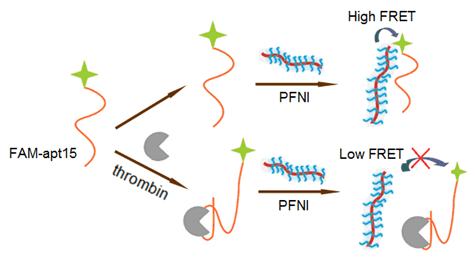| [1] Cera, E. D.; Dang, Q. D.; Ayala, Y. M. Cell Mol. Life Sci. 1997, 53, 701.
[2] Maragoudakis, M. E.; Tsopanoglou, N. E.; Andriopoulou, P. Biochem. Soc. T. 2002, 30, 173.
[3] Liu, C. W.; Huang, C. C.; Chang, H. T. Anal. Chem. 2009, 81, 2383.
[4] Song, W.; Zhang, Q.; Xie, X.; Zhang, S. Biosens. Bioelectron. 2014, 61, 51.
[5] Pavlov, V.; Xiao, Y.; Shlyahovsky, B.; Willner, I. J. Am. Chem. Soc. 2004, 126, 11768.
[6] Liang, H. R.; Hu, G. Q.; Xue, X. H.; Li, L.; Zheng, X. X.; Gao, Y. W.; Yang, S. T.; Xia, X. Z. Virus Res. 2014, 184, 7.
[7] Kim, Y. S.; Song, M. Y.; Jurng, J.; Kim, B. C. Anal. Biochem. 2013, 436, 22.
[8] Cao, H. Y.; Yuan, A. H.; Shi, X. S.; Chen, W.; Miao, Y. Oncol. Rep. 2014, 32, 2054.
[9] Song, Q. W.; Peng, M. S.; Wang, L.; He, D. C.; Ouyang, J. Biosens. Bioelectron. 2016, 77, 237.
[10] Neves Miguel, A. D.; Blaszykowski, C.; Thompson, M. Anal. Chem. 2016, 88, 3098.
[11] Jiang, L. Y.; Xiao, X. N.; Zhou, P. L.; Zhang, P.; Yan, Y. X.; Jiang, S. X.; Chen, Q. H. Chinese J. Anal. Chem. 2016, 44, 310. (姜利英, 肖小楠, 周鹏磊, 张培, 闫艳霞, 姜素霞, 陈青华, 分析化学, 2016, 44, 310.)
[12] Ge, J.; Liu, Z. F.; Zhao, X. S. Chinese J. Chem. 2012, 30, 2023.
[13] Zhang, S. B.; Zheng, L. Y.; Hu, X.; Shen, G. Y.; Liu, X. W.; Shen, G. L.; Yu, R. Q. Chinese J. Anal. Chem. 2015, 43, 1688. (张松柏, 郑丽英, 胡霞, 沈广宇, 刘学文, 沈国励, 俞汝勤, 分析化学, 2015, 43, 1688.)
[14] Wu, C.; Yang, S. Y.; Wu, Z. Y.; Shen, G. L.; Yu, R. Q. Acta Chim. Sinica 2013, 71, 367. (吴超, 杨胜园, 吴朝阳, 沈国励, 俞汝勤, 化学学报, 2013, 71, 367.)
[15] He, F.; Tang, Y. L.; Wang, S.; Li, Y. L.; Zhu, D. B. J. Am. Chem. Soc. 2005, 127, 12343.
[16] Chen, Z. B.; Tan, L. L.; Hu, L. Y.; Zhang, Y. M.; Wang, S. X.; Lv, F. Y. ACS Appl. Mater. Inter. 2016, 8, 102.
[17] Liu, X. F.; Shi, L.; Hua, X. X.; Fan, Q. L.; Chao, J.; Su, S.; Huang, Y. Q.; Wang, L. H.; Huang, W. ACS Appl. Mater. Inter. 2015, 7, 16458.
[18] Kong, L.; Xu, J.; Xu, Y.; Xiang, Y.; Yuan, R.; Chai, Y. Biosens. Bioelectron. 2013, 42, 193.
[19] Chen, Z. B.; Tan, Y.; Zhang, C. M.; Yin, L.; Ma, H.; Ye, N. S.; Qiang, H.; Lin, Y. Q. Biosens. Bioelectron. 2014, 56, 46
[20] Baek, S. H.; Wark, A. W.; Lee, H. J. Anal. Chem. 2014, 86, 9824.
[21] Jiang, C. N.; Liang, A. H.; Jiang, Z. L. Acta Chim. Sinica 2011, 69, 713. (蒋彩娜, 梁爱惠, 蒋治良, 化学学报, 2011, 69, 713.)
[22] Le Floch, F.; Ho, H. A.; Leclerc, M. Anal. Chem. 2006, 78, 4727.
[23] Zhao, J.; Hu, S. S.; Zhong, W. D.; Wu, J. G.; Shen, Z. M.; Chen, Z.; Li. G. X. ACS Appl. Mater. Inter. 2014, 6, 7070.
[24] Liu, L. Z.; Liu, Z. H.; He, Z. K.; Cai, R. X. Prog. Chem. 2006, 18, 337.
[25] Huang, F.; Wu, H. B.; Cao, Y. Chem. Soc. Rev. 2010, 39, 2500.
[26] Wang, M.; Li, C. H.; Lv, A. F.; Wang, Z. H.; Bo, Z. S. Macromolecules 2012, 45, 3017.
[27] Thomas, S. W.; Joly, G. D.; Swagger, T. M. Chem. Rev. 2007, 107, 1339.
[28] Rochat, S.; Swagger, T. M. ACS Appl. Mater. Inter. 2013, 5, 4488.
[29] Zhu, C. L.; Liu, L. B.; Yang, Q.; Lv, F. T.; Wang, S. Chem. Rev. 2012, 112, 4687.
[30] Wang, M. F.; Zou, S.; Guerin, G. Macromolecules 2008, 41, 6993
[31] Pu, K. Y.; Li, K.; Liu, B. Adv. Funct. Mater. 2010, 20, 2770.
[32] Zhang, Z. Y.; Lu, X. M.; Fan, Q. L.; Hu, W. B.; Huang, W. Polym. Chem. 2011, 2, 2369.
[33] Liu, X. F.; Shi, L.; Zhang, Z. Y.; Fan, Q. L.; Huang, Y. Q.; Su, S.; Fan, C. H.; Wang, L. H.; Huang, W. Analyst 2015, 140, 1842.
[34] Hu, W. B.; Lu, X. M.; Jiang, R. C.; Fan, Q. L.; Zhao, H.; Deng, W. X.; Zhang, L.; Huang, L.; Huang, W. Chem. Commun. 2013, 49, 9012.
[35] Jiang, R. C.; Lu, X. M.; Yang, M. H.; Deng, W. X.; Fan, Q. L.; Huang, W. Biomacromolecules 2013, 14, 3643.
[36] Zhang, Z. Y. Ph.D. Dissertation, Nanjing University of Posts and Telecommunications, Nanjing, 2014. (张志勇, 博士论文, 南京邮电大学, 南京, 2014.)
[37] Zhang, L. B.; Zhu, J. B.; Li, T.; Wang, E. K. Anal. Chem. 2011, 83, 8871.
[38] Golub, E.; Freeman, R.; Willner, I. Anal. Chem. 2013, 85, 12126.
[39] Lin, Z. H.; Pan, D.; Hu, T. Y.; Liu, Z. P.; Su, X. G. Microchim. Acta 2015, 182, 1933.
[40] Yang, X. H.; Wang, S. F.; Wang, K. M.; Luo, X. M.; Tan, W. H.; Cui, L. Chem. J. Chinese Univ. 2009, 30, 899. (羊小海, 王胜锋, 王柯敏, 罗晓明, 谭蔚泓, 崔亮, 高等学校化学学报, 2009, 30, 899.)
[41] Wang, Y. Y.; Liu, B. Langmuir 2009, 25, 12787.
[42] Liu, X. F.; Shi, L.; Hua, X. X.; Huang, Y. Q.; Su, S.; Fan, Q. L.; Wang, L. H.; Huang, W. ACS Appl. Mater. Inter. 2014, 6, 3406. |
